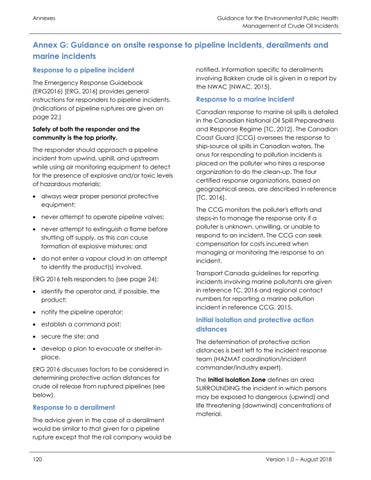Annexes
Guidance for the Environmental Public Health Management of Crude Oil Incidents
Annex G: Guidance on onsite response to pipeline incidents, derailments and marine incidents Response to a pipeline incident The Emergency Response Guidebook (ERG2016) [ERG, 2016] provides general instructions for responders to pipeline incidents. (Indications of pipeline ruptures are given on page 22.) Safety of both the responder and the community is the top priority. The responder should approach a pipeline incident from upwind, uphill, and upstream while using air monitoring equipment to detect for the presence of explosive and/or toxic levels of hazardous materials: • always wear proper personal protective equipment; • never attempt to operate pipeline valves; • never attempt to extinguish a flame before shutting off supply, as this can cause formation of explosive mixtures; and • do not enter a vapour cloud in an attempt to identify the product(s) involved. ERG 2016 tells responders to (see page 24): • identify the operator and, if possible, the product; • notify the pipeline operator; • establish a command post; • secure the site; and • develop a plan to evacuate or shelter-inplace. ERG 2016 discusses factors to be considered in determining protective action distances for crude oil release from ruptured pipelines (see below).
Response to a derailment The advice given in the case of a derailment would be similar to that given for a pipeline rupture except that the rail company would be 120
notified. Information specific to derailments involving Bakken crude oil is given in a report by the NWAC [NWAC, 2015].
Response to a marine incident Canadian response to marine oil spills is detailed in the Canadian National Oil Spill Preparedness and Response Regime [TC, 2012]. The Canadian Coast Guard (CCG) oversees the response to ship-source oil spills in Canadian waters. The onus for responding to pollution incidents is placed on the polluter who hires a response organization to do the clean-up. The four certified response organizations, based on geographical areas, are described in reference [TC, 2016]. The CCG monitors the polluter's efforts and steps-in to manage the response only if a polluter is unknown, unwilling, or unable to respond to an incident. The CCG can seek compensation for costs incurred when managing or monitoring the response to an incident. Transport Canada guidelines for reporting incidents involving marine pollutants are given in reference TC, 2016 and regional contact numbers for reporting a marine pollution incident in reference CCG, 2015.
Initial isolation and protective action distances The determination of protective action distances is best left to the incident response team (HAZMAT coordination/incident commander/industry expert). The Initial Isolation Zone defines an area SURROUNDING the incident in which persons may be exposed to dangerous (upwind) and life threatening (downwind) concentrations of material.
Version 1.0 – August 2018







